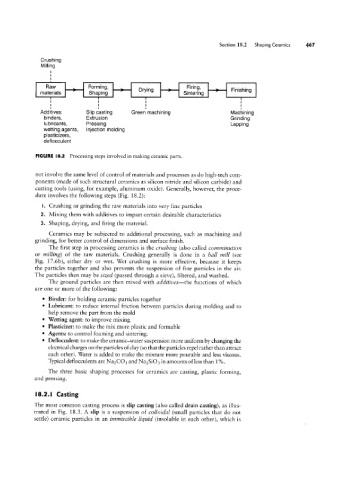Page 487 - Manufacturing Engineering and Technology - Kalpakjian, Serope : Schmid, Steven R.
P. 487
Section 18 2 Shaping Ceramics 67
Crushing
Milling
I
Haw Forming, Firing,
materials Shaping Drymg Sintering
.
I
Additives: Slip casting Green machining Machining
binders, Extrusion Grinding
lubricants, Pressing Lapping
wetting agents, Injection molding
plasticizers,
deflocculent
FIGURE l8.2 Processing steps involved in making ceramic parts.
not involve the same level of control of materials and processes as do high-tech com-
ponents (made of such structural ceramics as silicon nitride and silicon carbide) and
cutting tools (using, for example, aluminum oxide). Generally, however, the proce-
dure involves the following steps (Fig. 1S.2):
I. Crushing or grinding the raw materials into very fine particles
2. Mixing them with additives to impart certain desirable characteristics
3. Shaping, drying, and firing the material.
Ceramics may be subjected to additional processing, such as machining and
grinding, for better control of dimensions and surface finish.
The first step in processing ceramics is the crushing (also called comminution
or milling) of the raw materials. Crushing generally is done in a ball mill (see
Fig. 17.6b), either dry or wet. Wet crushing is more effective, because it keeps
the particles together and also prevents the suspension of fine particles in the air.
The particles then may be sized (passed through a sieve), filtered, and washed.
The ground particles are then mixed with additives-the functions of which
are one or more of the following:
° Binder: for holding ceramic particles together
° Lubricant: to reduce internal friction between particles during molding and to
help remove the part from the mold
' Wetting agent: to improve mixing
° Plasticizer: to make the mix more plastic and formable
° Agents: to control foaming and sintering.
° Deflocculent: to make the ceramic-water suspension more uniform by changing the
electrical charges on the particles of clay (so that the particles repel rather than attract
each other). Water is added to make the mixture more pourable and less viscous.
Typical deflocculents are Na2CO3 and Na2SiO3 in amounts of less than 1 %.
The three basic shaping processes for ceramics are casting, plastic forming,
and pressing.
l8.2.l Casting
The most common casting process is slip casting (also called drain casting), as illus-
trated in Fig. 18.3. A slip is a suspension of colloidal (small particles that do not
settle) ceramic particles in an immiscible liquid (insoluble in each other), which is

